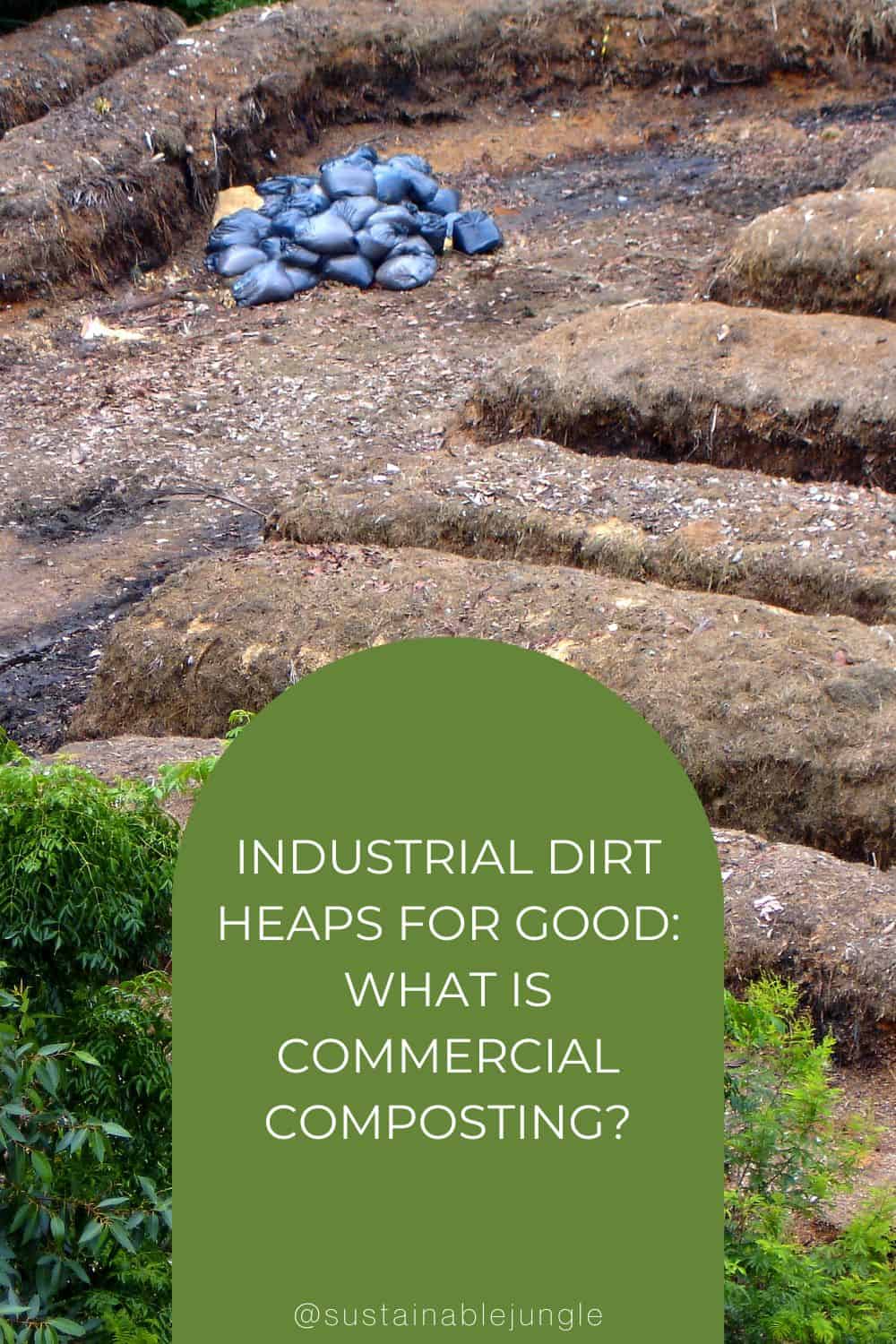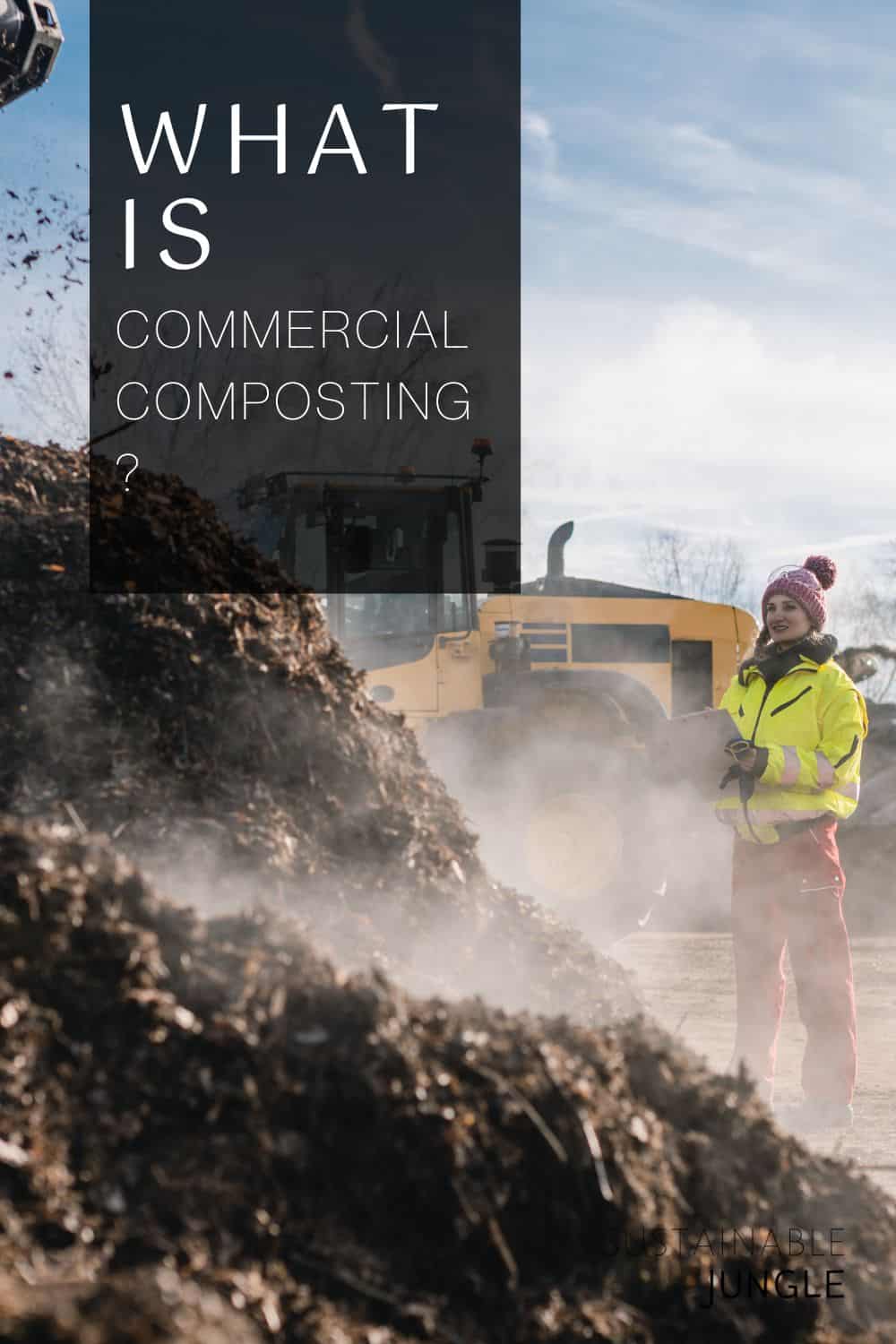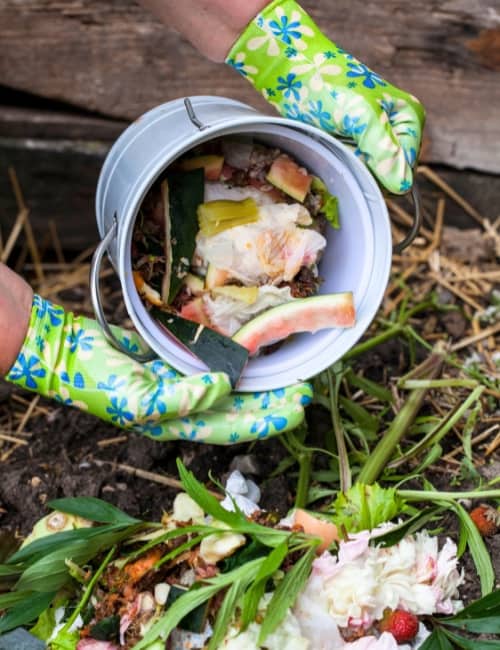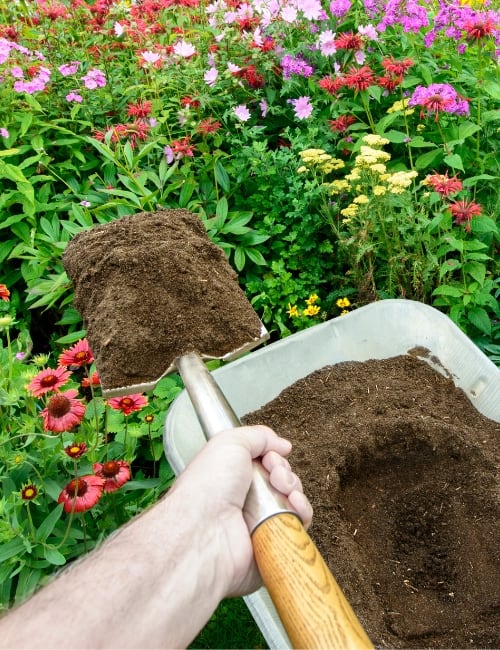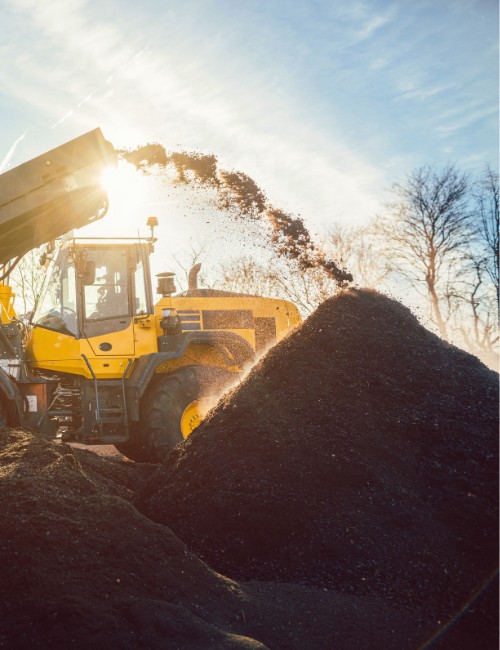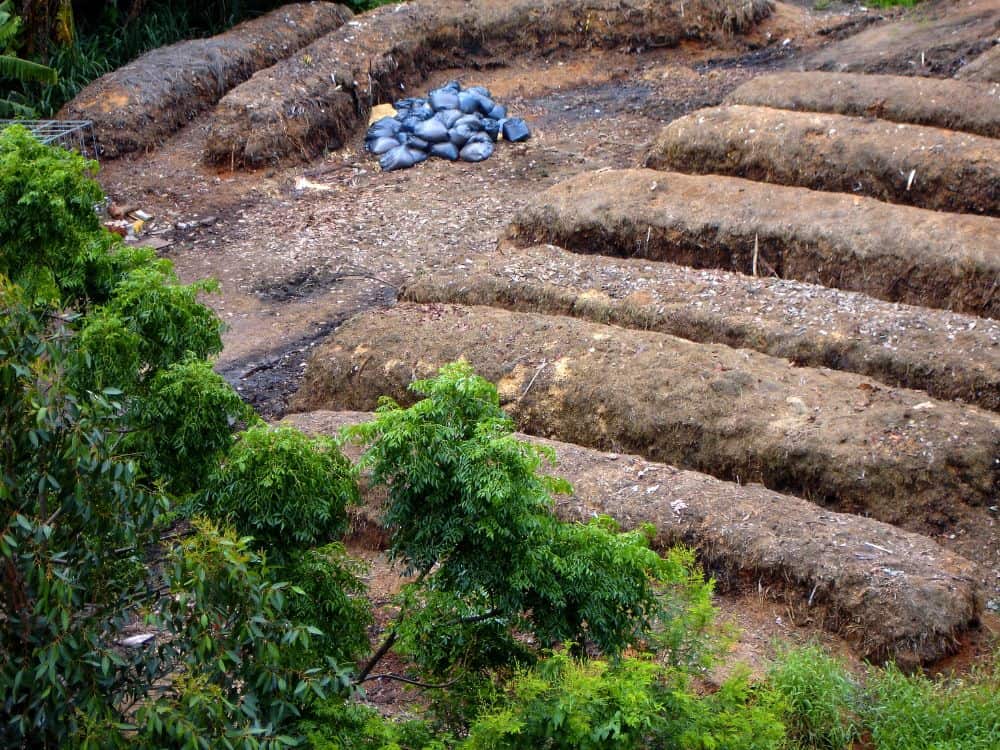
Industrial Dirt Heaps For Good: What is Commercial Composting?
Composting is trending.
It’s a crucial means of reducing landfill waste and if implemented on a wide scale, home and commercial composting alike significantly reduces factors that contribute to climate change (hello, methane emissions).
The process of composting also generates a useful and much needed substance: humus, which garden enthusiasts refer to as “black gold” because of compost’s magic ability to feed plants and revitalize soil.
Don’t have a sustainable garden?
The world still needs your organic waste!
The Food and Agriculture Organization (FAO) warns that 90% of our topsoil faces degradation by 2050, and compost is one of the best solutions we’ve got to overcome this, maintain fertile grounds, and preserve future food supplies.
The EPA’s Municipal Solid Waste report reveals that over half of landfill waste was actually compostable. Half!
Of the 292.4 million tons of waste in 2018, only 25 million tons were composted, meaning the composting rate of municipal waste disposal is less than 0.1%.
So what is commercial composting and more importantly, how does commercial composting work?
In the following, we’ll explore how industrial composting systems differ from home composting and why they have potential for such large-scale positive environmental impact.
Industrial Composting Systems Facts & Figures
- What is industrial composting?
- Commercial composting vs home composting
- Industrial composting guidelines & standards
- What is and isn’t commercially compostable?
- Why industrial scale composting is important
- Challenges to the industrial compost industry
- How to find municipal composting programs
1. What Is Industrial Composting?
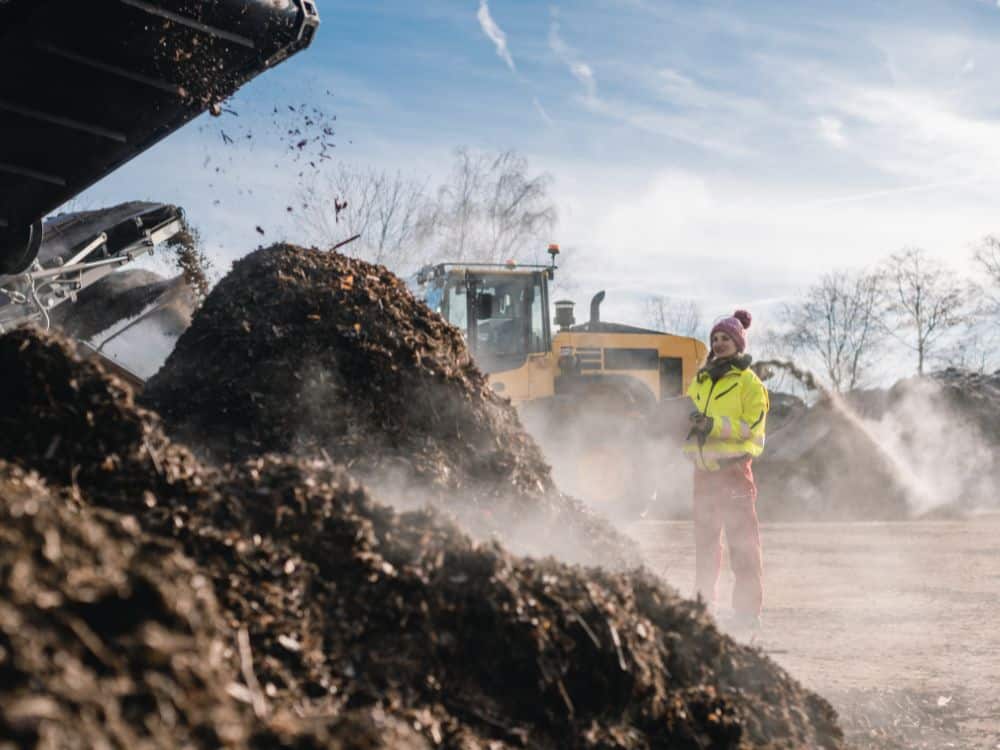
The words “commercial” or “industrial” might get a bad rap in sustainable living circles, but when it comes to commercial or industrial) composting, they’re exciting.
Why?
Because they give far greater access to the most responsible waste disposal method we have.
As a refresher composting in general is the process of biodegradation and then repurposing of natural waste. Essentially, composting is nature’s magical, cyclical way of recycling organic matter.
Many local governments are now implementing commercial composting systems, which are large-scale biological waste removal processes specifically designed to manage a high volume of organic waste from neighborhoods.
But how does industrial composting work?
Industrial Composting Process
- Households or restaurants make the commitment to separate garbage waste from organic waste. The bio waste is collected in a (usually) green commercial composting bin that goes curbside for pick-up on schedule determined by the municipality.
- Bio waste is delivered to a compost processor to make sure it is properly sorted. Anything that doesn’t belong is removed.
- Organic materials are separated into nitrogen-rich and carbon-rich. The nitrogen rich compost is mixed into a sludge.
- The carbon-rich items like branches and paper are then mixed in with the nitrogen sludge at a specific ratio.
- Carbon and nitrogen compost are placed into long rows of dirt that are watered and mixed daily.
- Environmental conditions produce a nutrient-rich dark soil after approximately a month, which is typically then sold to farms, nurseries, and eco-friendly landscaping companies who use it as a nutrient-rich tool for farming and growing.
How long does this process take? Or how long does it take to make commercial compost?
It varies slightly, but most commercial composting systems can fully break down waste in 60–90 days.
What Are The Methods Of Industrial Composting?
Industrial composting facilities tend to be quite large, and are placed either in large warehouses to control odor or spread out in remote open areas.
There are three main commercial composting methods:
- Windrow Composting: In the windrow composting approach, waste is accumulated into long rows and aerated periodically by watering and turning the compost piles. These piles are approximately 14-16 feet wide and 4-8 feet tall.
- In-vessel Composting: Organic material is added to a silo, drum or concrete-lined trench at the industrial composting facility for in vessel composting, where the environment is specially controlled by the waste management facilities to ensure a hot, effective, and fast process.
- Aerated Static Pile Composting: For static pile composting, the compost is piled large and layered loosely with bulking agents (woodchips, shredded paper, etc) which ensure that air filters through the heap. A series of pipes on the ground blow and suck air, which speeds up the natural composting process.
2. Commercial Composting Vs Home Composting
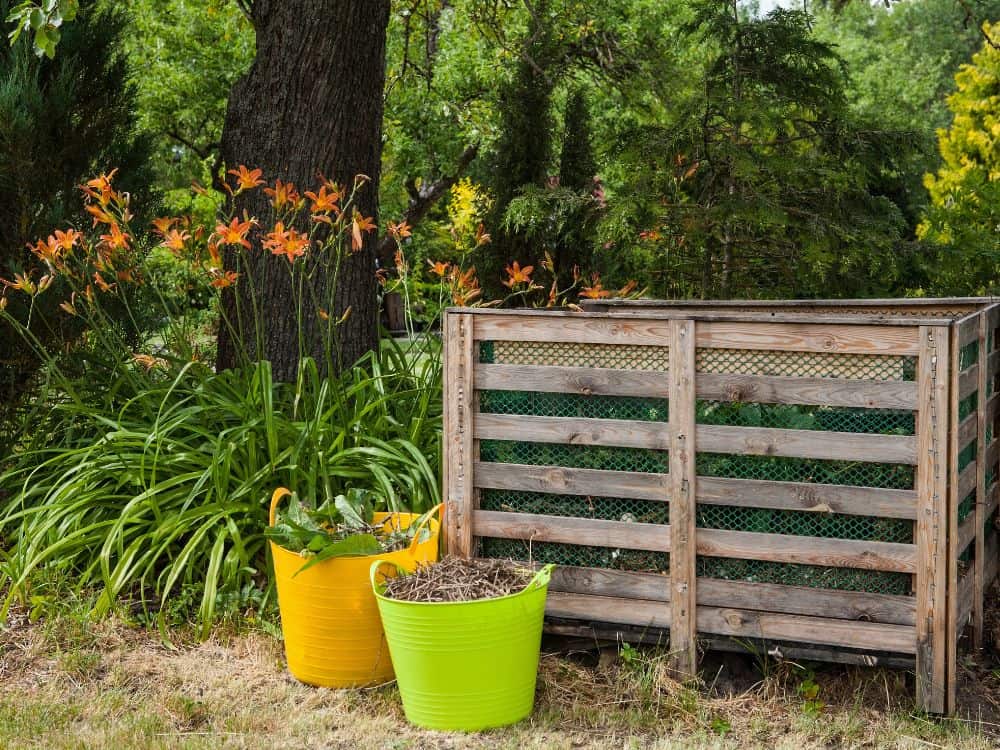
Maybe you’re already on board the composting train, but is that indoor compost bin the same thing as small-scale commercial composting?
Not exactly.
So what is the difference between commercial and home composting?
The most important distinction between backyard composting and using a commercial composting facility is that not everything that is commercially compostable (plastic of plant-based origins, for instance) is home compostable, too.
This is because the heat, moisture, and conditions at an industrial composting facility tend to be much more powerful upon the composting process than at home.
While home composting, yard and food waste can take up to six months to completely regenerate as nutritious soil, active industrial composting takes only a few weeks to a month, and then cools until ready to use.
That isn’t to say home composting isn’t good. In fact, it’s the opposite. We encourage a home composting routine and that you provide anything that cannot be composted at home to municipal facilities via an industrial compost bin if you have them available.
These are some items that are not compostable through private or home composting, but that can be composted industrially, such as:
- biodegradable items (like some sustainable food packaging solutions)
- bioplastic packaging
- biodegradable trash bags
- most compostable bags
- compostable food carriers
- dryer lint
- cat or dog poop
- eco-friendly cat litter
- fish bones, animal bones, or meat
- milk, cheese, oils, or butter
Commercial composters can break these complex products down, since they have a higher heat and proper machinery that aids in the decomposition process.
In terms of what other items commercial composting companies will accept (we’ll get to that next), it’s also worth noting certifications and compostable standards become important here, since facilities often won’t touch certain items without them, even if they are technically compostable.
Federal Trade Commission (FTC) guidelines mandate that marketing and packaging of anything “compostable” has to specify where something can be composted and must outright state if the item cannot be home composted.
3. Industrial Composting Guidelines & Standards
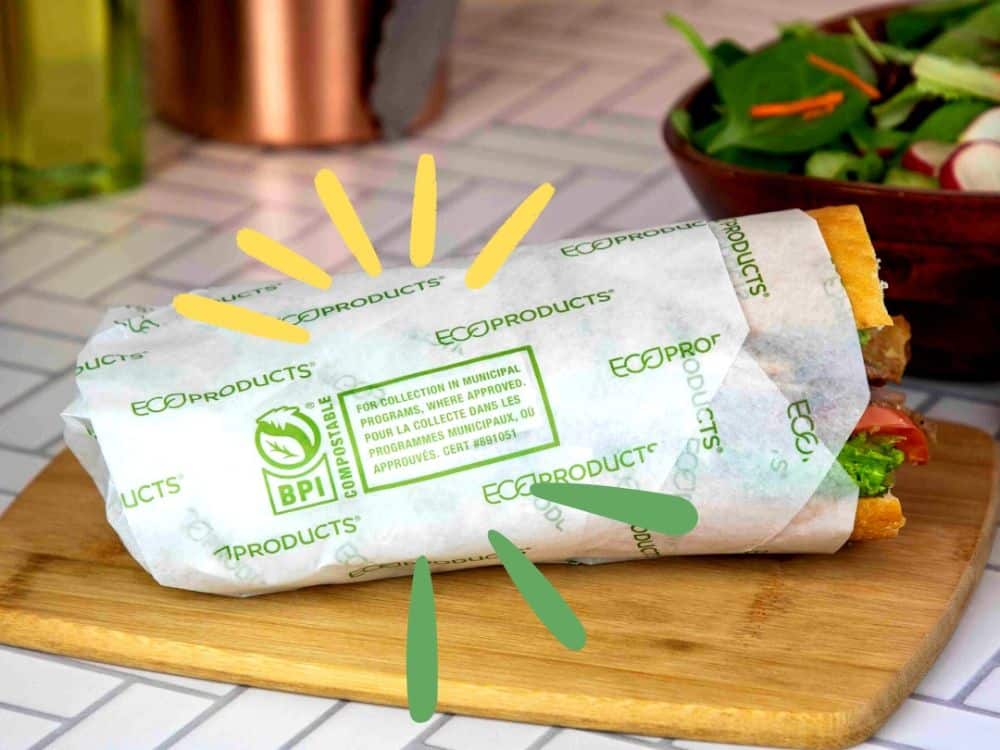
It can feel like you need a degree in composting when you really get into the nitty-gritty of what biodegradable and compostable mean.
What you need to know here is that there are three subsections to authenticating the commercial compostability of products:
- ASTM International sets definitions and standards
- Biodegradable Products Institute (BPI) provides the third party certification of the standard being upheld
- Federal Trade Commission (FTC) enforces against false or deceptive product labeling.
With that in mind, let’s break it down further.
FTC guidelines say, in terms of compostability, that the item must break down in equal time as the materials it is being composted with, or 180 days maximum.
And while making false compostability claims is illegal, FTC guideline adherence isn’t the same as having a certification.
For certifications, there are two relevant standards:
- Biodegradable Products Institute (BPI): The most reputable certifier of commercially compostable products. To avoid confusion, see their labeling guidelines or their searchable database to double-check a brand’s “certified” claims.
- USDA BioPreferred: It’s the closest thing the US has to a biodegradability certification, but it’s NOT a certificate of complete biodegradability. Though the minimum biobased content required varies, the baseline is just 25%.
Both of these certify products based on standards set by ASTM International. These evidence-based standards ensure a product fully breaks down within the permissible time (180 days or fewer for commercially compostable items).
There are three ASTM compostability standards, which are designed for commercial composting sites:
- ASTM D6400: To pass this baseline test, the material must biodegrade “at a rate comparable to known compostable materials” and produce usable compost.
- ASTM D6868: Identical to above but for paper materials coated with a bioplastic film (i.e. paper coffee cups with a waterproof PLA laminate). This certification ensures it will ALL compost in municipal facilities.
- ASTM D6866: A radiocarbon analysis that finds a material’s bio-base carbon to its “fossil carbon”. Lots of dense science, but essentially, the presence of carbon 14 indicates a material will compost into biomass rather than fossil fuels.
In short, as per the ASTM, an industrially compostable material has to “reach or exceed 90% conversion of the carbon within the material into carbon dioxide (CO2)” during a specific time frame (usually 180 days).
While there are some European home composting standard certifications, none of these ASTM standards certify home compostability, so any company that claims their products are home compostable based on these standards (and some do!) is straight-up lying.
An ASTM home composting standard has supposedly been in the works for years, but there is no news or indication as to when this will become a reality.
4. What Is & Isn’t Commercially Compostable?
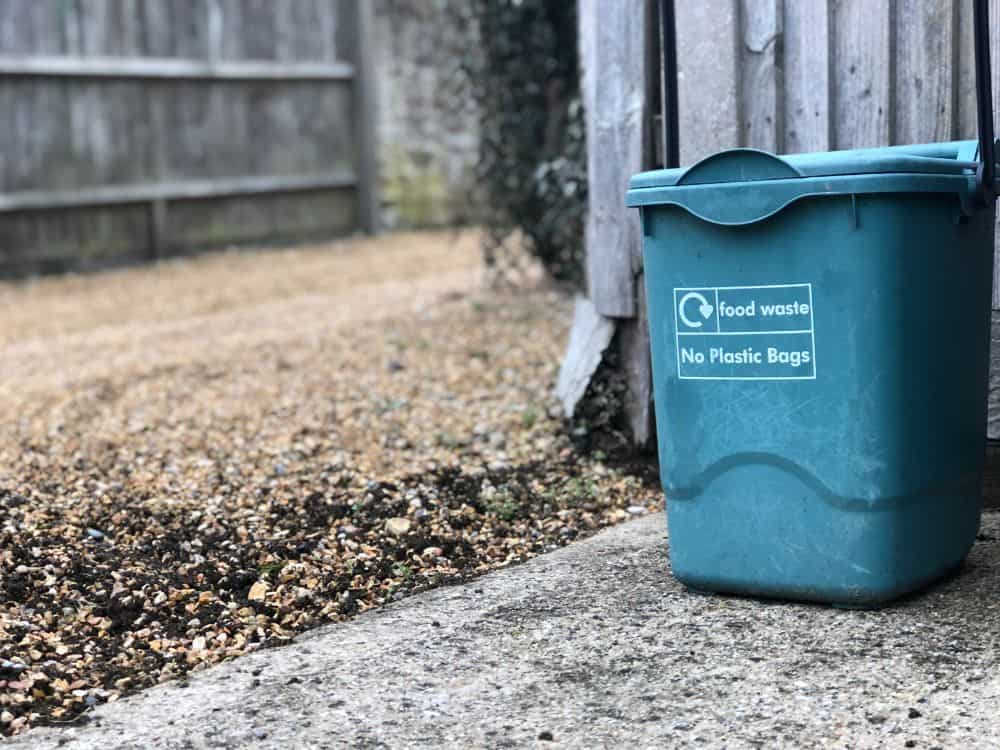
So what does commercially compostable mean in a more practical sense? What can we actually toss in our commercial compost bin?
Let’s first define “commercially compostable”: Anything that can wholly decompose into natural elements without leaving toxic residue in a relatively short period of time (which is a significant distinction when talking about things that are biodegradable or compostable).
For example, 100% organic cotton shirts are considered compostable because they will break down back into humus and carbon (the finished product of the process we call compost).
Versus, say, a synthetic fabric that breaks apart merely into smaller microplastics (leaving toxic residue behind) over the course of many years, which is 100% not compostable.
Here’s our in-depth video explainer on this topic.
Typically, your backyard compost pile has more limits to what it can compost than the commercial composting process.
Just about any plant or animal product can become compost eventually. Some need more heat and time to do so. And because commercial facilities have large, professionally managed compost heaps, this isn’t really an issue for them.
Every large scale composting center accepts different composting material, so it’s a good idea to check in with yours. As a general rule of thumb, though, these larger-scale operations can handle anything your backyard can—plus oils, grains, meats and sometimes bioplastics.
In terms of what is commercially compostable, here are some items that can always be sent to commercial composting facilities (though it’s worth noting some of these items also fall into the list of what is compostable at home)
- Meat, dairy, seafood, bones, and other protein-based food scraps
- Fruit (no stickers!), vegetables, nuts, seeds
- Eggshells
- Grains
- Coffee grounds and filters
- Yard waste, garden waste, grass clippings, wood chips
- Large food items
- Oil, butter, and oil-soaked food
- Biodegradable Products Institute (BPI) certified industrially compostable bags and products
- Compostable plastics (needs to have ASTM D6400 or EN13432 certification)
Items that CANNOT be handled by commercial composting equipment:
- Glass, plastic, or metal
- Personal hygiene items or medical waste
- Styrofoam
Items that are SOMETIMES accepted by commercial compost centers (check locally):
- Compostable bags
- Compostable cutlery and containers
- Used paper towels, paper plates, and other paper products
- Textiles (usually must be tagged as 100% certified organic cotton, hemp fabric, linen, or lyocell, for example)
5. Why Industrial Scale Composting Is Important
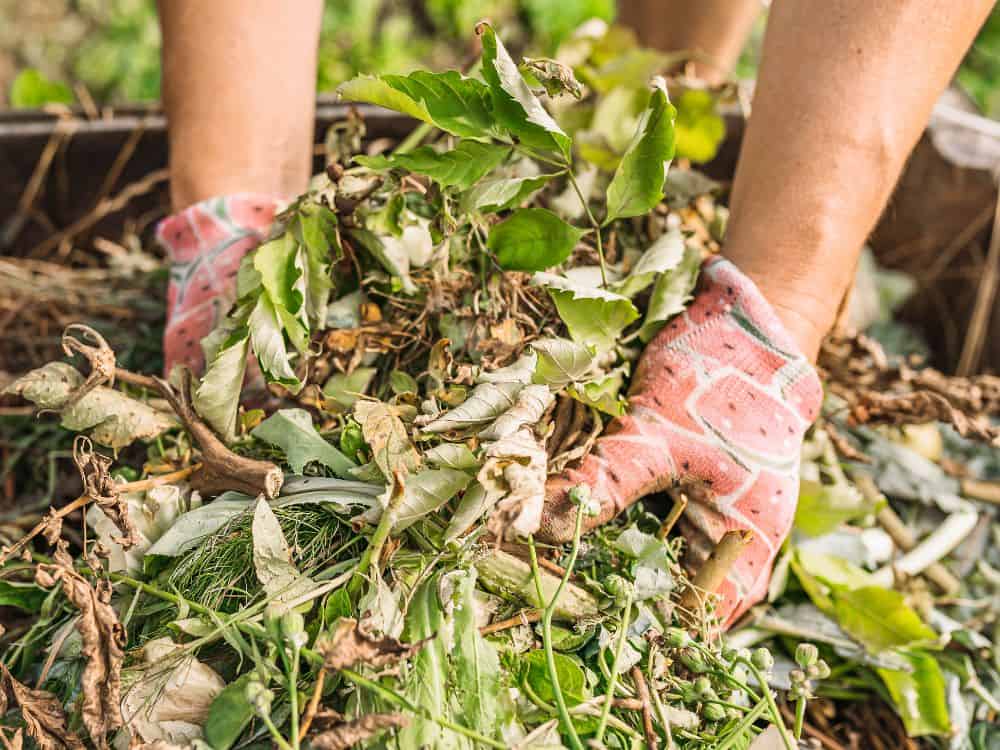
Plastic and landfill pollution is one of the most pressing environmental crises of our time.
But as bad as plastic is, organic waste going to landfills is even worse. That’s because, when organic material decomposes anaerobically (without oxygen, as it will do when buried under tons of trash), it releases methane gas, which is 25x more potent than CO2.
Composting avoids this by breaking down waste aerobically (with oxygen).
According to one EPA study, 56% of non-industrial food waste in the USA went to landfills while just 4% was composted.
That’s at least 30.6 million tons of food waste per year that’s becoming greenhouse gasses instead of being converted back into usable organic material for farming, landscaping, and growing.
Commercial composters not only keep our leftover organic materials from becoming greenhouse gasses in landfills, but they also turn our waste into something environmentally beneficial.
Even if individuals or families don’t have space or time to compost, municipal composting solutions provide a food waste solution through ease of access to facilities making “black gold” for our planet.
It’s called humus (not the kind with pita bread) and it’s able to rehabilitate depleted soil, neutralize its pH levels, and replenishes it with carbon nutrients like phosphorus, potassium, and nitrogen.
It also creates a solid soil surface to prevent soil erosion. That also means improved workability of tricky soil types, which then also means it becomes especially useful to reforestation and environmental restoration.
Humus can also regulate soil temperature, which extends the growing season, and increases moisture retention, so you save money, time, and water. And when we look at this through a wider agricultural lens, it promotes higher farm crop yields.
Plus, industrial composting provides soil that is a natural pesticide, natural fertilizer, and even helps clean up toxic spills in the environment through something called bioremediation!
If this hasn’t been enough of a reason to get excited about compost’s potential to help rehabilitate ecosystems, read more fun composting facts to get you stoked on the magic of worms and muck.
Thanks to commercial composters, currently approximately 8.5% of America’s biowaste is composted. Some cities, like Seattle, now even mandate composting. But this is still the minority; most cities offer NO composting service.
As of 2015, municipal composting programs served a mere 4 million U.S. households, and other countries around the world continue to develop their composting programs.
Clearly, we have a lot of room for growth when it comes to proliferation of the municipal composting business—until people don’t have to desperately Google “commercial composting facility near me” to find one.
6. Challenges To The Industrial Compost Industry
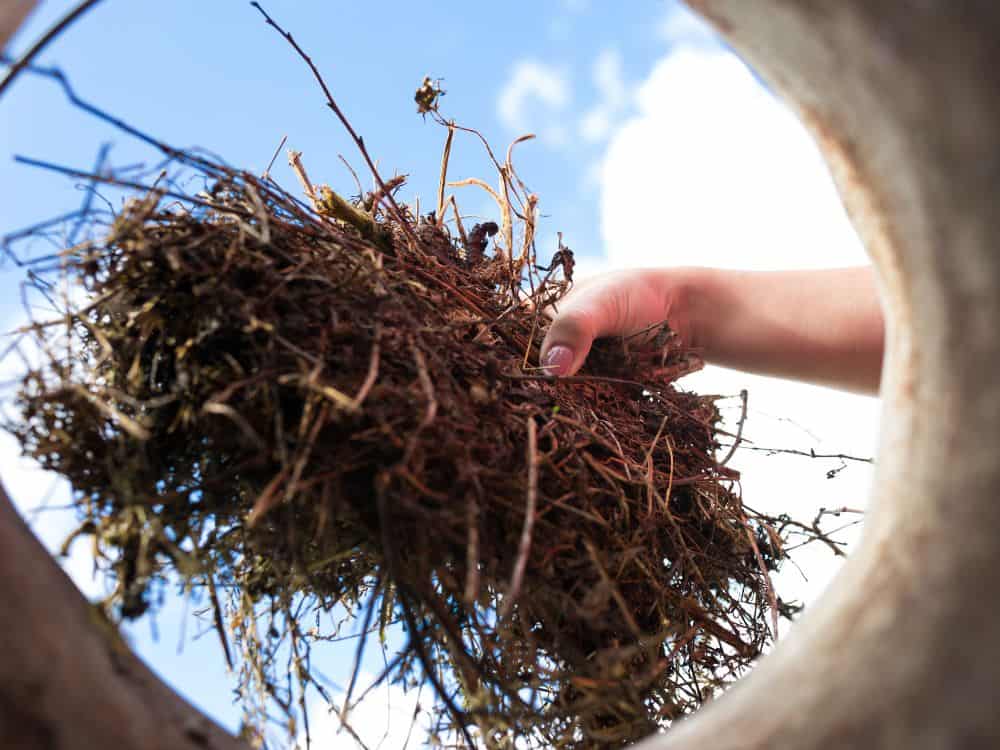
Currently, there are two main challenges to commercial composting operations:
- Contamination
- Education
Contamination
Regular garbage is the main compost contaminant. These nonbiodegradable bits and bobs might not even hurt the breakdown process, but separating the garbage from the compost is necessary… and messy, dirty, and inefficient.
But who wants to purchase peat-free compost with bits of plastic or other debris inside?
Composting really only works as a type of recycling if the end product is high quality compost.
And controlling the quality of the compost when you can’t control the inputs is a challenge. Compostables can likewise have other contaminants. Imagine piles of leaves covered in motor oil or chemical fertilizers, or a single elastic band left in the waist of otherwise totally organic underwear left in a collection of organic matter.
This is why most municipal compost products can’t qualify for an organic label or certification. The best that the U.S. Composting Council currently offers is a “Seal of Testing Assurance.”
Education
Education is a challenge not only in terms of getting the good word out about composting, but also educating people about what composting is and how it works.
Luckily though, this seems to be shifting, with schools and municipalities turning to composting as alternative waste disposal. After all, they work.
For example, when Portland implemented a curbside composting project in 2012, it resulted in 44% less residential trash in just six months!
7. How To Find Municipal Composting Programs
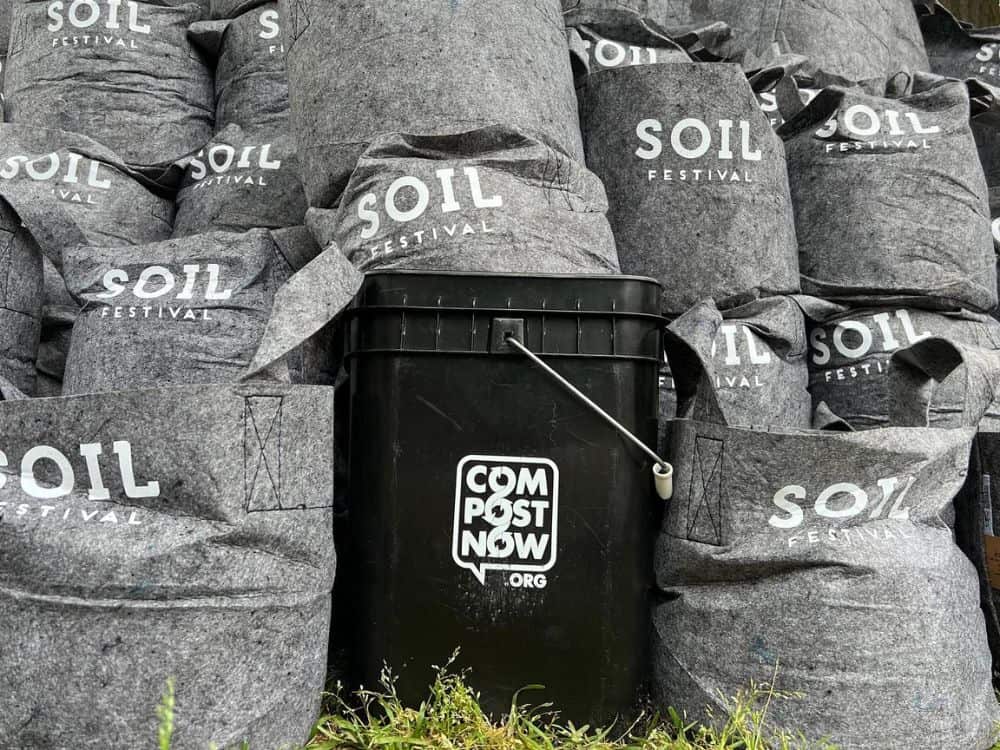
Composting is one of the most life-changing sustainability practices out there—whether you’re pursuing low waste living or just looking for some of the most impactful sustainability tips.
So it’s hopeful to see highly populous cities like Portland, OR and New York, NY offering curbside pickup for composting alongside the usual recycling and trash. They even provide a starter kit and green waste bins!
If publicly funded compost programs haven’t been established yet where you live, don’t be discouraged. There are private composting services like Compost Now in the US which offer accessible monthly subscriptions for domestic compost collection.
You can also use BioCycle’s Find a Composter to locate an industrial composting facility for drop-off near you.
Plus, this interactive website offers interesting stats and mapping to composting urban access in the US.
Still no commercial composting facilities in your area and ready to make a change?
Pressure your local government to make the leap to compost heaps.
As New York City’s municipal composting cost benefit analysis showed, composting ends up saving not only the planet, but saving money, too.
Wait, is industrial composting profitable?
Yes! After all, landfills are a huge financial drain on cities and thus taxpayers.
Plus, many cities charge for trash services and even some rural areas have pay-per-pound landfill policies—while these same sites then offer free yard waste composting and recycling services.
Did you know we Have a Newsletter?
We cover the latest in sustainable living, fashion, zero waste, beauty, travel, finance and more…
Final Thoughts On Commercial Municipal Composting
Collectively, individuals can make a hugely positive impact on the health of our planet by composting regularly.
With the massive amount of waste that humanity generates, industrial composting facilities should be the number one destination for residential, commercial, and industrial organic waste streams.
So whether you’re trying out apartment composting, vermicomposting, or just wish you had a better solution to kitchen scraps, participating in commercial composting ensures we divert up to 50% of landfill-bound waste back into healthy and nutritious soil.
Next time you take out the trash, take a peek: how much of it could be composted?
After all, composting is a literal game-changer in the fight against carbon emissions–so what are you waiting for?
Share this article with your friends and neighbors today, and make way for local, industrial, municipal composting.
Pin these:
